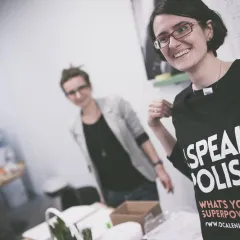One of the culinary questions I have been asked many times by my friends from Poland and abroad during the many years I have spent in Warsaw is: how to make a real Italian pizza and whether it’s difficult. I must admit that Warsaw is now full of Italian pizzerias which use exclusively Italian ingredients, but still the pleasure of serving your friends a home-made pizza is very tempting.
Before we start to analyse the dough and the ingredients, let’s have a brief look at the history of pizza.
The ancestor of pizza was the so-called focaccia, a meal well-known in Ancient Rome already. The focaccia was usually prepared out of spelt, a kind of wheat used very often by the Romans. As a matter of fact, the word farina (flour in Italian) comes most probably from the word faro (spelt).
The word pizza comes presumably from the word pinsa, the Latin participle of the verb pinsere, which means: to knead, to grind, to smash.
The first known recipes for pizza date back to the beginning of the XVIth century. They come from cookery books and culinary dissertations found in the north of Italy, in Venice. The form and the method of preparing pizza that they described was very different to these we know nowadays. “Pizza” was called a thin cake based on eggs, butter and sugar, which was baked in the oven or fried: it resembled rather a flan than a pizza.
After the discovery of America, many new products came to Europe, such as corn, tomatoes, potatoes, bean, pepper and courgette, and in the course of time the extra vergin olive oil replaced animal fats such as lard. In addition, pizza started to be seasoned with cheese and aromatic spices, like oregano and basil.
It wasn’t until the second half of XVIIIth century that the Neapolitans started to add to pizza tomatoes and mozzarella di bufala, because in those days those products weren’t well-known in Italy yet – they only appeared in Europe after the discovery of America.
The first recipe for Neapolitan pizza as we know it today dates from the middle years of the XIXth century. The first Margherita was baked in one of the popular pizzerias in the city center by Raffaele Esposito, who created it on the occasion of the Queen’s visit. The pizza was supposed to celebrate the unification of Italy. Esposito was inspired by the colours of the Italian flag and used three simple ingredients – mozzarella, tomatoes and basil, which represented the colours: white, red and green.
The Queen (and not only the Queen!) liked the pizza so much that the meal was given her name and is today one of the most known Italian products in the world.
The name of every pizza comes from the way it was seasoned: pizza alla marinara (pizza with anchovies), al prosciutto (with ham), all’aglio e olio (with garlic and olive oil), al pomodoro (with tomato sauce), ai funghi (with mushrooms), al formaggio (with cheese) etc.
How to make a pizza
There are many ways of preparing pizza:
- with the use of the dough that can be bought in the bakery.
It’s the oldest and the most difficult way, and therefore also the most time-consuming one, because the dough needs to be kneaded three times in a row.
- with the use of fresh brewer’s yeast. You can find it in many shops, its expiry date is quite short.
- with the use of dry granulated brewer’s yeast. Its expiry date is longer and it’s easier to store it at home.
It’s hard to say which of these methods is the best; you have to try yourself and choose your favourite one.
RECIPE FOR THE PIZZA DOUGH
Ingredients:
1. wholemeal or half wholemeal flour: about 500 g
2. fresh brewer’s yeast: about 30 g
3. extra vergine olive oil: 6 or 7 spoonfuls
4. water
5. salt
Sprinkle the flour on the moulding board or (even better) on a marble surface, crumble the yeast and dissolve it in several spoonfuls of warm water, then add it to the flour. Add olive oil and salt. Add water slowly, stirring all the time until you obtain a uniform, soft mass, easy to knead. Knead the dough for a couple of minutes until its consistency is elastic. Next form a uniform ball out of the dough, sprinkle it with flour and put it in a warm place, covering it with a cloth. Let the dough grow – it must double in volume. (2,5-3 hours)
Once the dough has grown, put it on the moulding board (previously sprinkled with flour) and start to roll it out evenly until the dough has the classical, round shape (or rectangular, if your baking form is rectangular). The dough shouldn’t be more than 0,5 cm thick. Before you put it into the oven, make small holes in the surface with a fork.
When it comes to spices, you can now give free rein to your imagitaion. Tomato sauce, cheese, olives, oregano, basil, ham, mozzarella, artichokes, anchovies, garlic, onion – whatever you like!
THE BAKING TIME
If we are using a traditional wood-fired pizza oven, we will bake pizza over fire. The baking time is very short then; about 10 minutes should be enough at 300-350 degrees. The oven must be well heated. It’s very difficult to tell how much time our pizza needs; when you have some experience you will know immediately if it’s ready. It also depends on how far the pizza is from the fire. If we are using an electric oven, the baking time will be longer (about 25-30 minutes at 250 degrees). In this case I advise you to put in the oven a dish with a litre of water – this will keep the oven moist and our pizza won’t get dry.
Well, now I have nothing to do but to wish you bon appetit!
Giovanni Genco
Translated by: Anna Bień









